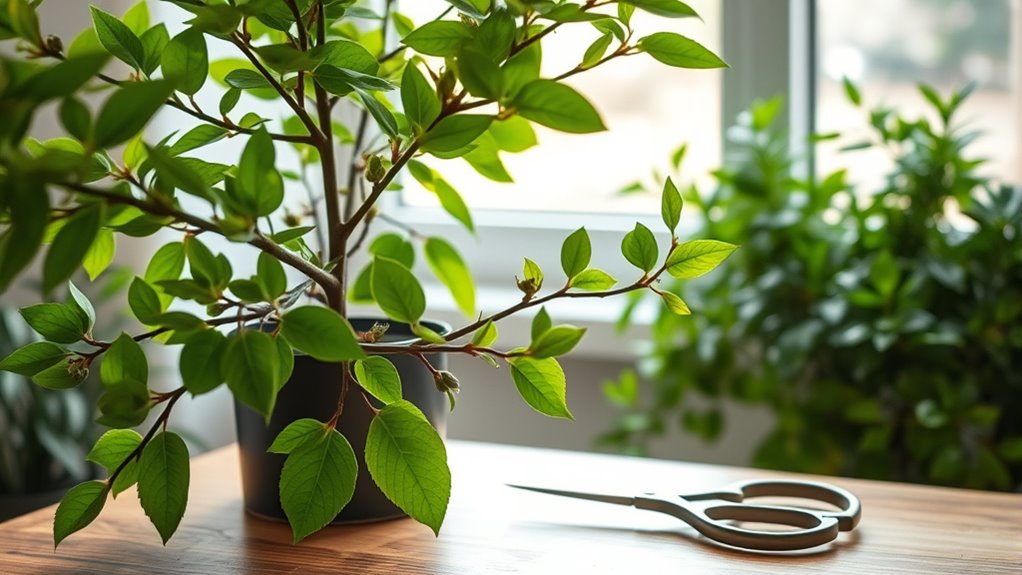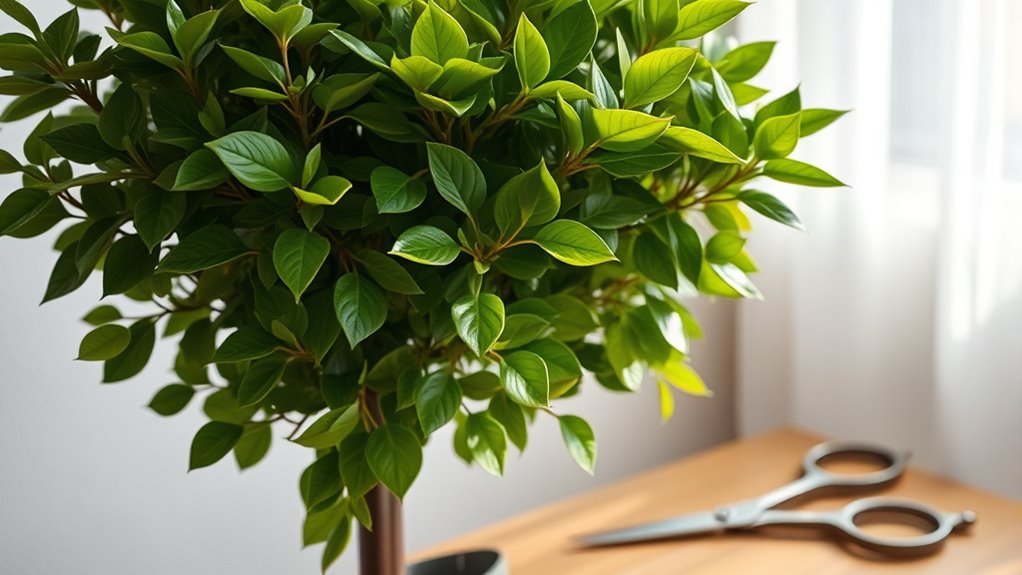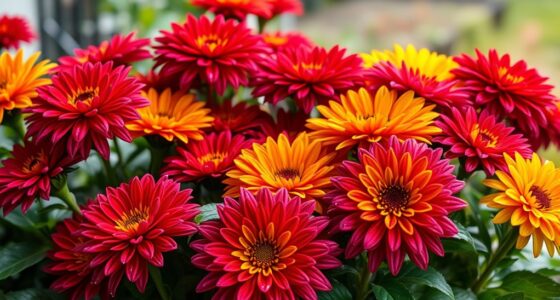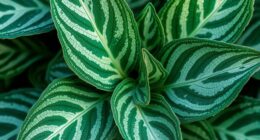To achieve bushier indoor plants, focus on advanced pruning techniques like selective pruning, which involves cutting specific stems just above leaf nodes or buds to encourage new growth. Pinching the tips of new shoots also stimulates side branches, creating a fuller appearance. Remember to sterilize your tools and prune during active growth for the best results. Keep experimenting with these strategies, and you’ll uncover even more ways to boost your plant’s lushness.
Key Takeaways
- Use selective pruning to remove specific stems or branches, stimulating new shoot growth and increasing bushiness.
- Make clean cuts just above leaf nodes or buds to promote healthy, vigorous new growth.
- Pinch tips of new growth to encourage side branches and a fuller, denser plant structure.
- Combine pruning with consistent watering and pest control to support recovery and growth after trimming.
- Sterilize tools before pruning to prevent disease spread and ensure healthy, vigorous plant development.

Have you ever wondered how to keep your indoor plants healthy and looking their best? The key lies in mastering advanced pruning techniques that promote a bushier, more vibrant growth. But before diving into pruning, it’s essential to understand the importance of proper watering schedules and pest control. Consistent watering ensures your plants stay hydrated without overwatering, which can lead to root rot. When you prune, you remove old, damaged, or diseased stems, so maintaining a balanced watering routine supports the plant’s recovery and new growth. Additionally, keeping pests at bay prevents infestations that can weaken your plants and hinder their growth. Regularly inspect your plants for pests, and use gentle, organic methods to control any issues before pruning.
Once your watering schedule is on point and pests are under control, you can start implementing advanced pruning techniques to encourage bushier growth. One method involves selective pruning, where you cut back specific stems or branches to stimulate the development of new shoots. This technique helps create a fuller, denser appearance by encouraging lateral growth. When pruning, make clean cuts just above a leaf node or bud to ensure healthy new growth. You can also use pinching, which involves pinching off the tips of new growth with your fingers or trimming shears. Pinching encourages the plant to produce side branches, resulting in a more compact and bushy shape. Be cautious not to over-prune; removing too much at once can stress the plant and slow its recovery.
Selective pruning and pinching promote bushier, healthier indoor plants.
Another advanced technique is thinning, where you remove entire stems or branches that are overcrowded or crossing each other. This not only improves air circulation but also directs the plant’s energy toward developing a denser, healthier canopy. When thinning, cut back to the main stem or branch junction, ensuring your cuts are precise and clean. This promotes better growth and reduces the risk of pests taking hold in crowded, damp areas. As you prune, always sterilize your tools to prevent the spread of diseases, and remember to prune during the plant’s active growth period for the best results.
Incorporating these advanced pruning techniques into your routine will give your indoor plants a more lush, bushy appearance. Just keep in mind that consistent watering schedules and vigilant pest control are fundamental to supporting your pruning efforts. With patience and precision, you’ll see your plants transform into vibrant, full-bodied focal points in your space.
Frequently Asked Questions
How Often Should I Prune My Indoor Plants for Maximum Bushiness?
You should prune your indoor plants based on their growth cycle and a consistent pruning schedule. Typically, every 4 to 6 weeks, you can trim new growth to encourage bushiness. Keep an eye on your plants; if they start to look leggy or sparse, prune more frequently. Regular pruning stimulates new growth, making your plants fuller and healthier, so adjust your schedule as needed to maintain the desired bushiness.
What Tools Are Best for Precise Pruning of Indoor Plants?
To achieve precise pruning of your indoor plants, you should use sharp tools like pruning shears and precision scissors. Pruning shears are perfect for cutting thicker stems, offering clean, controlled cuts. Precision scissors excel at trimming delicate or detailed areas, helping you shape your plant accurately. Always guarantee your tools are clean and sharp to prevent damage and disease. This way, you’ll promote healthy growth and maintain a lush, bushy appearance.
Can Pruning Help Indoor Plants Recover From Pests or Diseases?
Pruning can definitely help your indoor plants recover from pest damage or disease. By removing infected or damaged leaves and stems, you prevent the spread and encourage healthy growth. Regular pruning also improves air circulation and light penetration, which supports disease recovery. Just make sure to use sharp tools and sterilize them afterward to avoid spreading pests or pathogens. With proper pruning, your plants can bounce back stronger and healthier.
Are There Specific Pruning Techniques for Flowering Versus Foliage Plants?
You might wonder if there are specific pruning techniques for flowering versus foliage plants. For flowering plants, focus on flowering plant techniques like deadheading and pruning after blooms to encourage more flowers. Foliage plant trimming, on the other hand, involves removing dead or yellow leaves to promote healthy growth. Tailoring your pruning approach helps each plant thrive, ensuring vibrant blooms or lush foliage, depending on the plant’s needs.
How Do I Prevent Over-Pruning and Damage to My Indoor Plants?
Think of pruning as a gentle dance, not a reckless stomp. To prevent over-pruning and plant stress, don’t buy into pruning myths that suggest more is always better. Instead, prune wisely, cutting only what’s necessary, and leave healthy growth intact. Regularly assess your plant’s response, and avoid removing too much at once. Your plant will thank you for your careful touch, thriving with balanced, healthy growth.
Conclusion
By applying these advanced pruning techniques, you can encourage your indoor plants to grow fuller and healthier. Remember, regularly pruning can increase plant bushiness by up to 50%, promoting better airflow and light penetration. With consistent care, you’ll enjoy lush, vibrant foliage year-round. So, stay attentive to your plants’ needs, prune wisely, and watch your indoor garden thrive with a more robust, bushier appearance. Your efforts will definitely pay off in a healthier, more beautiful space.










